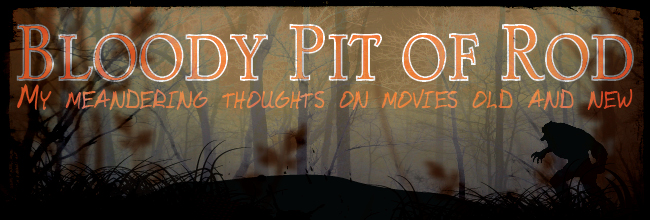
The recent release on Region 1 DVD of DELLAMORTE, DELLAMORE under its less attractive US title of CEMETARY MAN made me dig out my old essay on the film and its symbolic content. Originally printed in one of the last issues of European Trash Cinema here it is in slightly altered form for 2006. Enjoy!
Oh! And Spoiler alert for those yet to see the film!
Michele Soavi's DELLAMORTE DELLAMORE is one of the best and most inventive horror films of the 1990's. In its beauty and violence, we can see its relationship to the work of Fulci, Romero, and of course Argento, but I think there is an even more fruitful way of examining this movie. Its surface story is a simple zombie tale spiked with humor and tragic romance and is thoroughly enjoyable on this level alone. However, this film is rife with symbolism of a complexity and depth that I have rarely seen in a horror movie. Every character and every scene has a symbolic part to play in an examination of (as the title says) Death and Love. Each time I watch the movie I see more and more, but instead of a scene by scene look at the film, I'll present a broad overview.
I noticed that the symbols come in sets of three. For instance, Francesco, Gnaghi, and Franco are all elements of the same person; Francesco falls in love with three different women; and romantic love is divided into three levels. The movie can be seen as an examination of Francesco's life with what we see as the afterlife. Francesco, because he is the center of the story, is how he lived his life. Gnaghi is the representation of the baser side of man that we grow out of, and Franco is the responsible man he could have grown into. The scenes that show these relationships are many. For instance, although Gnaghi speaks only in grants, Francesco replies in full sentences implying that he hears more than we do. Franco is Francesco's only friend and takes credit for his murders- murders he can logically have had no knowledge of. Also, Franco seems to most often call when Francesco is in the shower or in some other contemplative mood. Each character is a facet of life and how we live it or death and how we accept it.
The set of three that I find most intriguing is the three women that Dellamorte falls in love with. The fact that they are all played by the same woman made me curious and a little thought reveals what they represent. They symbolize the three classical ways that men view women throughout life--mother, virgin, and whore.
Francesco is not alive until the first woman enters his life. He decides that he must have her and this is his birth which is symbolized by him climbing out of the freshly thug grave. The widow is the mother figure-she is the first woman we love. (As for why the husband is dead, might there be some hint in the euphemistic term for the orgasm as "the little death.") This obviously plays off the Freudian Oedipal complex-the desire to love the mother and replace the father. The desire for the father's place and the fear of his discovery of that desire is exactly how the scene plays out. The film tells us the return of this man is not right because, until now the dead had come back only after 7 days, but the husband/father returns in direct response to the son (Dellamorte) physically loving the mother. This causes the mother's death but it is by the son's hand, not the husband's. This could symbolize the pain of childbirth and the agony of letting go of the grown child. (How sharper than a serpents tooth...) Also, later, it is the mother who wounds Francesco as a parallel to how our mothers forever influence the way we view women. The pain may not kill you, but it does color your perspective on love.
The second woman is representative of the way men view their first love-as a virgin. She is literally a virgin because of her phobia about sexual penetration and they fall instantly in love with each other because in this world "Who else is there?" Francesco responds to her the way we all do to first love, by doing anything to keep and make her happy. For Dellamorte, this means having his penis removed or made nonfunctionable. Any man willing to emasculate himself must truly be in love! But while he is recovering from this sacrifice, the woman is stolen from him in the standard cliched manner. She falls in love with someone who is beneath her and who treats her horribly. This other person takes her virginity and her love. As a parallel to teenage heartbreak, this makes perfect sense.
The third woman is the whore, representing the bitter way men see women after rejection and heartbreak. We should suspect this as she is very sexual from her first moment on screen. She says she loves him and wants him to stay with her. But sadly, he learns of her true nature from someone else and his response is as strong as the betrayal. His disgust with the whore is the final death of love within him. He is now bitter and wholly incapable of loving again. "This time I'm really through with love." Francesco's murder of the whore is not so much the killing of another person as it is killing the love within himself. Defeated in his quest for love three times, he can never trust again and therefore never love again.
Since Gnaghi and Franco are part of Francesco, their relationship with love is very interesting. Gnaghi represents puppy love, almost more enamored with the idea of love than with the object of his love. Gnaghi's love is complete with just the head of his beloved to cherish. Sexuality is unnecessary and (from his reactions to Francesco's love making in the film) disgusting. Exactly the response expected from the adolescent version of Dellamorte. With Francesco as the maturing man searching for love in the middle, we come to Franco as the representative of adult responsibility at the end. He is married with a family and a steady solid job-the perfect example of standard social mores. But Francesco tells Franco in a phone conversation that eventually his wife will leave him, his daughter will grow up to hate him and then he will be free. This view of love as fleeting, brief, and as solid as sand is the real cause of Dellamorte's misery. When the core reason for happiness is fated to always desert us, how can a thinking individual be truly happy? For Gnaghi/ Francesco/Franco, all three levels of love (childish/adolescent/mature) fail and serve only to point the way to the grave.
Another set of three that begs for analysis is the three people that Francesco kills in Franco's hospital room. Coming as they do after Dellamorte's swearing off of love, I feel that they represent his rejection of the higher authorities that promise happiness. First to die is the symbol of religious morality, the nun. Killing her is a rejection of the false hope of redemption held out by the church as the reward for a "good" life. Next is the doctor as a symbol of society. Killing him is a refusal to go along with the multitude of evils that society expects from us to keep the status quo. Then the nurse comes in and asks what has happened. Francesco says that they killed each other and that it was a settling of scores suggesting that perhaps society and morality are destined to destroy one another. The nurse is humanity and horrified at the rejection of the two accepted pillars of sane life. Francesco's killing of her is his repudiation of all authority and the world itself. His next move is obvious- escape. But if this is the after life, there is no escape and that is what he discovers.
I would like to stress that this is merely one way of looking at the film. After a theatrical viewing of the movie with three friends, I was swamped with other possible interpretations of the same events. One friend in fact made it a personal quest to come up with as many different readings of it as he could, as fast as he could. Some of them were amazing and some were goofy as hell, but when was the last time a horror film caused this kind of discussion? There's plenty to see in DELLAMORTE DELLAMORE and this just scratches the surface.







No comments:
Post a Comment